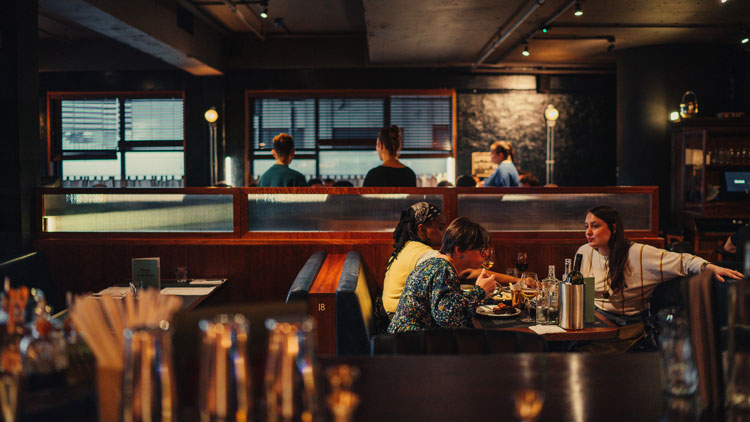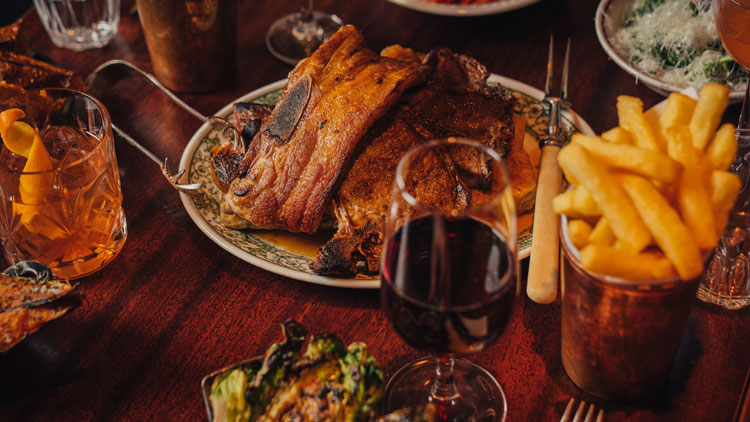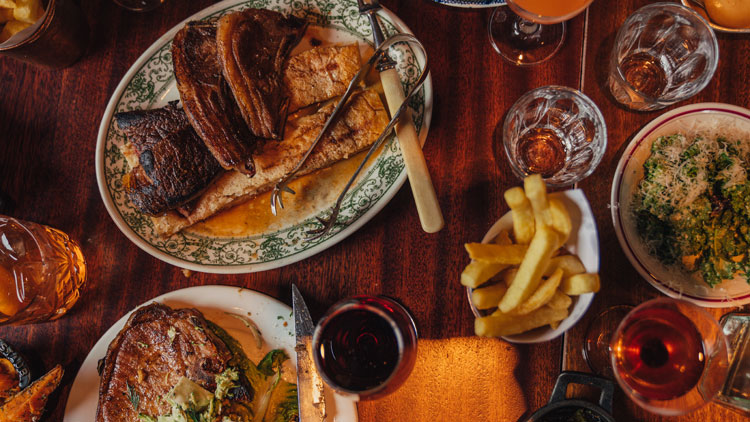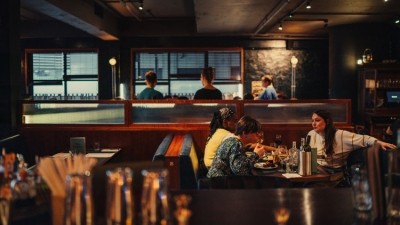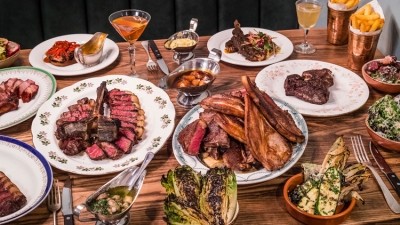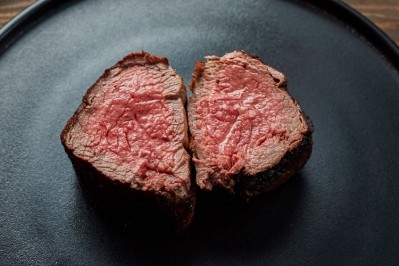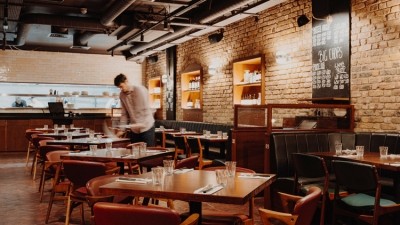Business Profile
Wharf fare: Blacklock’s Gordon Ker on taking chops to Docklands

In an area of London where the glass tower is king and where restaurants tend to occupy sensibly shaped modern boxes, the new Canary Wharf project from chophouse group Blacklock is something of an outlier. Located in a former warehouse in an angular site with pillars, the new restaurant is tucked away under the railway tracks, with the building vibrating every time a train passes over it.
This might not seem very City slicker, but it is very Blacklock. According to the group’s charismatic founder Gordon Ker, docklands has been on the company’s radar for some time. The problem, he says, was that until recently it was proving near impossible to find a site suited to the chop-focused brand and Ker’s penchant for more characterful locations.
“Canary Wharf is an area that we genuinely have been looking at for a number of years,” says Ker a few weeks before the opening of the new restaurant, the fifth in his group. “Some people do it down, but I really like the history of docklands, and the markets and the trading that used to happen here. But it was just the architecture that was an issue.
“The buildings don't really lend themselves to a Blacklock. We always go for very characterful heritage buildings (Soho Blacklock is in a former basement brothel, its City restaurant occupies an electricity substation while Blacklock Shoreditch is based in an old furniture factory), and you don't really find that in Canary Wharf. You find glass boxes underneath high-rise office towers. It’s all very formal, shiny and quite un-Blacklock. We never go for that on the main thoroughfare, site, it’s not in keeping with our style.”
Docklands as a destination
With a suitable site finally located Blacklock Canary Wharf opened last month. At 4,000sq ft and with 120 covers, it is the biggest restaurant the group has opened so far and one that sees new elements designed to cater more specifically to the area’s demographic.
As well as a restaurant offer, Blacklock Canary Wharf is the first in the group to offer a standalone bar menu in what Ker hopes will strike a chord with the Canary Wharf clientele but also suit its under the tracks location. “It’s in keeping with that idea that trains go over the top like they do in places in New York, where people stand at the bar having cocktails and oysters and slamming burgers,” he says Ker. “That was the kind of a thing that we thought we could do here.”
Alongside Blacklock’s typical chop-focused offer Canary Wharf’s bar menu offers items including pork scratchings; French-dipped bone marrow buns; and pigs in nuggets. In another first, the restaurant also serves a crab rarebit, the first seafood dish on any Blacklock menu.
“Each time we open a new restaurant, it should look, smell, and feel like a Blacklock, but it should also have its own character and identity. That comes from the fit out and the design but also from the menu. Here you can come and sit at the bar have some bone marrow and anchovy soldiers and a martini and leave, or perhaps then stay for dinner.”
Canary Wharf is currently experiencing a restaurant renaissance with a new breed of operators challenging the dominance of some of the area’s earlier settlers, which include Big Easy, Boisdale, Goodman, Iberica, Roka, and Plateau. More recent entries include Dishoom, Hawksmoor, Emilia’s Crafted Pasta, and M Restaurants with more big names also set to open there this year. For Ker, it was no-brainer.
“Canary Wharf is very busy for restaurants, but it's a very busy place with people who live and work here. People who will come to us in Canary Wharf are probably not coming to any of our other restaurants. This feels like a very new area for us.”
The location also offers a lot of potential for Blacklock, which occupies a space in the dining sector almost exclusively on its own. Although the area is not short on steak restaurants, Blacklock’s chop focus sets it apart from many of its potential rivals, as does its famously accessible price point.
“We feel like we can bring something new to Canary Wharf,” adds Ker. “There are lots of new places here, but we believe we can bring something different, whether that be the building and our style or with what we offer, which is great quality and great value.”
A value for money proposition
Value has been the cornerstone of Blacklock since Ker opened the first restaurant in Soho back in 2015. Current menu items include a steak sarnie for £12, steaks that range from £14 to £20 and sides that don’t go north of £4.50.
Its most popular option, the ‘all in’ for two or more people features pre-chop bites followed by a mound of beef, pork and lamb skinny chops on charcoal-grilled flatbreads with a choice of sides for £25 per person.
"We make less money on food and drink
than other restaurants. This might not be the
right approach, but it's our approach”
The group also runs a Butcher Price Mondays initiative where it says its big chops cost the same price as at a local butcher.
Blacklock’s prices remain competitive (Ker says the group never raised its prices pre Covid). In fact, they are even more so in the current climate where rampant food inflation and energy costs have forced most restaurant businesses to increase prices. The group isn’t immune to these pressures but has worked hard to keep its price rises to a minimum.
“Some prices have gone up, but we lag inflation. We're focused on being better internally, so that we can continue to pass on value to our guests, because that positive bill shock is what we want with people feeling like they should be paying more.”
Ker says the group has achieved this by engineering its menu over time and introducing dishes that support value and use the whole animal (its pig's head on toast is its bestselling starter).
The way it works with its suppliers is another factor. The group sources its meat from butcher and farmer Philip Warren, which Ker describes as “the most expensive meat we could buy in the country”. “We work with them on a whole animal basis so that we can do as much as possible to limit waste. This means we take more off their hands and so can demand a bit better pricing than if we were to just cherry pick certain cuts of meat, which would mean that they'd have a load of surplus that they can't get rid of.
“We have so many conversations about what else we can do before we have to move the price. We make less money on food and drink than other restaurants. But we try and drive more volume and catch up in other areas. This might not be the right approach, but it's our approach.”
Measured expansion
Blacklock launched in 2015 in Soho and has since followed up with sites in the City and Shoreditch. Its most recent opening before Canary Wharf was in Covent Garden in 2022, arguably its most mainstream location, albeit in an underground site on Bedford Street.
With Blacklock having only opened five sites in eight years, it’s fair to say the group has taken a measured approach to expansion. Growth has always been on the cards, but not at the expense of quality, which is why it has not put its foot to accelerator when it comes to expansion, says Ker.
“Our main strategy focuses around being better and better. We don't want to grow and see dilution at the same time. We want to deepen and improve what we're doing so the challenge is always how do we do this better? How do we tell the design story better? How do we get the quality of the food better? How do we improve on the atmosphere, the service?”
The challenge, he says, is to grow both as a restaurant and as a people first company. “Our goal is to be a brilliant place to work and that's actually more important than being a brilliant restaurant, because we believe that if we do that, then the restaurants will be great.
“Challenges come from growth and in the standards we hold ourselves to in doing things better than what we did a year ago or two years ago.”
To achieve this, Blacklock employs the principle of the power of 1%, whereby the business keeps evolving to become 1% better time and time again. “We talk about always getting a little bit better every day,” says Ker. “And by doing that, you'll see massive growth over the course of time and a kind of cumulative growth on growth.”
This might sound like management speak but it’s a principle Ker holds dear, with the power of 1% taken into account by managers in weekly focus meetings. “The power of 1% is a genuine value, it runs through the company. It’s something that you will hear people in meetings talk about. Rather than talking about development or training or getting better at something they will refer to the power of 1%.”
In practice he says that every time a new restaurant opens it should be the best restaurant yet – in terms of food, décor, atmosphere, service - because it puts to use all the learnings of previous openings. Once this has been achieved, it is then a matter of bringing all the existing restaurants up to this new benchmark.
People who will come to us in Canary Wharf
are probably not coming to any of our other
restaurants. This feels like a very new area for us”
An example of this was when Blacklock City opened with the introduction of starters for the first time to suit the more conventional way of dining that City patrons were used to. Soho initially launched just offering the ‘all in’ but learnings from the City restaurant informed the group that people across London preferred a starter, main and dessert experience, which is now found at all of its restaurants.
Another tangible way of achieving the 1% is with its workforce. Canary Wharf was able to make use of existing staff across the group rather than employing everyone afresh, making it much easier to instil the Blacklock culture from the off.
“When we have one restaurant and you go to two restaurants you can't really take from one, you really are robbing from Peter to pay Paul. Whereas now with five restaurants, we've been able to move people from a few other restaurants to create a team with 10 to 15 really strong people ready.
“Then we can backfill roles across the whole company, which is smoother than hiring a load of new people into one site and expecting a new team to form magically.”
Ambitions beyond the capital
Like many small restaurant businesses, Ker cites his people as the main reason for Blacklock’s continued growth. If there isn’t the offer of career progression, he fears he will struggle to hold onto talent. “If we don’t have the growth people will leave.”
Cost pressures in the capital means that Blacklock might look elsewhere for expansion. Ker describes the relationship with his landlords during lockdown as a “score draw” with two of its landlords being very accommodating and supportive and the other two less so and says the current landscape is tough. Although landlords in general were keen to offer deals immediately after the pandemic, now that it is a memory the challenges with taking on property that existed pre Covid have re-emerged.
“In the property market I don't see many deals going or offers of cheap rent. The demand for opening a restaurant in parts of London where we would look to open a restaurant is really high, so the price that people are paying is high.”
In the future, then, it seems likely the group look further afield when considering sites, with cities like Manchester an obvious target
“I prefer the idea that there are many other cities outside of London that don’t have a Blacklock yet but have the demographic of London and great people and culture and the ability to do great restaurants,” says Ker.
“We definitely like growing outside of London from a brand perspective.”
